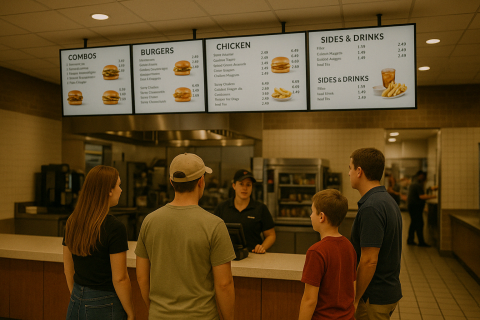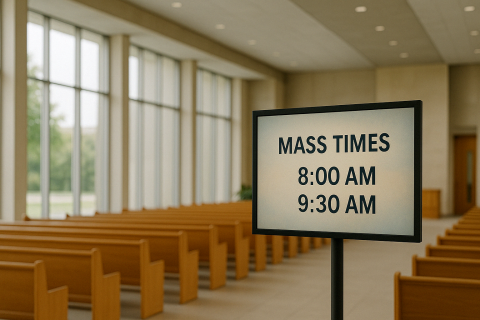Supermarket digital signage has become a pivotal tool for modern grocery stores. By showing promotional offers, product details, and other dynamic content, grocery retailers can boost sales, improve in-store navigation, and elevate the overall customer experience. This article highlights the key benefits and applications of digital signage in supermarkets and explains how to roll out a digital signage deployment quickly and easily with Screenly.
Key Takeaways
-
Digital signage in grocery stores and supermarkets transforms customer engagement by providing real-time, engaging content that personalizes and streamlines the in-store shopping experience.
-
Proper placement of digital signage displays and digital screens helps capture attention, direct customers to key areas, and encourage impulse purchases through timely promotional offers.
-
Technologies like digital wayfinding make store navigation smoother, increasing customer satisfaction and loyalty.
-
Supermarket digital signage can boost sales and increase sales by highlighting promotions, featuring loyalty programs, and creating a more engaging shopping experience that keeps loyal customers coming back.
-
Choosing scalable technology and the right digital signage software—alongside secure hardware—ensures retailers can manage multiple locations effectively while protecting both their data and brand image.
Understanding supermarket digital signage
At its core, digital signage uses electronic digital displays and digital screens to deliver targeted information. In retail stores like grocery stores, this technology replaces static posters with eye-catching, dynamic shelf displays and storefront screens that can be updated instantly. The ability to show real-time promotions means food retailers and supermarkets can adapt swiftly to shifting inventory or customer trends.
By incorporating digital signage for grocery stores into a location’s layout, retailers can effortlessly guide customers to specific product locations, share store hours or store events, and even rotate social media feeds or user-generated content to build deeper connections with shoppers. When supermarkets move from traditional signage to supermarket digital solutions, they reduce the need to constantly print new materials and can quickly respond to real-time data.
Types of digital signs for grocery stores
Implementing the right types of digital signs and signage for grocery stores can significantly enhance the shopping journey and drive sales. Below are some popular formats that deliver a more engaging shopping experience:
Digital menu boards
Placed in deli sections or food-service areas, digital menu boards and digital menus let retailers display prices, nutritional details, and rotating specials. They simplify updates for weekly promotions or changes in loyalty programs, making it easier to keep customers informed.
Digital end caps
Sometimes called digital end-cap displays, these are located at the ends of aisles and are ideal for highlighting promotions, high-margin products, or limited-time promotional offers. Their strategic placement in high-traffic areas encourages impulse purchases and increases brand awareness.
Digital shelf labels
Replacing printed price tags with dynamic shelf displays enables real-time updates for stock, pricing, and promotions. They’re perfect for signage for grocery stores that frequently adjust pricing and want to quickly access or change product details.
Digital signage screens
Large digital signage screens or storefront screens can be positioned near entrances or checkout lanes to display engaging content like new deals, fun facts, or even social media feeds. These screens help capture attention and keep the customer shopping experience fresh.
Enhancing customer experience with digital displays
Modern digital displays are far more than static signage. They transform the in-store shopping experience through real-time updates on product locations, prices, and current sales, helping shoppers make informed decisions. By using digital signage screens to demonstrate recipes or share fun facts about certain products, retailers foster a more immersive environment that resonates with customers.
These digital advertising tools not only present key messages but also incorporate user-generated content and interactive elements that spark curiosity. For example, an eye-catching video wall might feature cooking demos or brand stories to keep shoppers engaged. Overall, these dynamic methods help shoppers move more seamlessly through the store, resulting in a more enjoyable and engaging shopping experience that can increase sales and build brand loyalty.
Boost sales with dynamic promotions
One of the most powerful ways to boost sales and drive sales with grocery store digital signage is to showcase and display dynamic promotions. By placing digital signage displays in high-traffic areas—such as the entrance, the checkout line, or end-of-aisle sections—stores can strategically encourage impulse purchases. These visible, frequently updated messages entice customers to grab last-minute items, helping retail stores move surplus inventory or spotlight high-margin products.
Additionally, leveraging social proof testimonials or user-generated content—on digital screens further influences buying decisions. For example, featuring real-time social media highlights or loyalty programs can build trust and nudge shoppers to try new products. By consistently adjusting and refining digital content based on performance metrics, retailers can keep more customers excited about what’s on offer.
Navigating the store with digital wayfinding
Large supermarkets can feel like a maze, especially for new or hurried shoppers. Digital wayfinding systems can guide customers effortlessly, helping them locate high-margin products, find product details, and discover new sections. By incorporating easy-to-read maps, digital end cap signs, and aisle pointers, retailers simplify store navigation and streamline the entire customer journey.
Switching out traditional signs for digital signage screens also allows for on-the-fly updates when store events or layout changes occur. Shoppers can quickly identify where to find seasonal products, new arrivals, or daily specials, which ultimately creates a more engaging shopping experience. This well-organized, time-saving approach helps direct customers to items efficiently and enhances overall grocery shopping satisfaction.
Leveraging real-time updates
Keeping customers informed of real-time promotions and fresh deals is essential for any supermarket. Digital signage is an excellent tool for sharing up-to-the-minute pricing, promotional offers, or store alerts. By programming digital signage content to reflect immediate stock changes, retailers can promote limited quantities or new arrivals before items run out.
Digital menu boards and other digital signage screens can show time-sensitive data, such as flash sales or special events. This dynamic approach entices shoppers to act quickly on enticing discounts or new product lines, effectively driving impulse purchases. As a result, the store benefits from consistent engagement while customers enjoy a timely, interactive shopping experience.
Utilizing digital menu boards
Digital menu boards—often seen in cafés, delis, and prepared-food counters—let retailers show off daily specials, nutritional information, and appealing food images. These digital signs offer the flexibility to update content as frequently as needed, making them a perfect fit for grocery stores that want to display weekly promotions, highlight seasonal favorites, or promote weekly specials in their ready-to-go food sections.
By using digital menus, stores can easily alter pricing or switch out items for different meal times, which helps manage stock and reduce waste. This adaptability also encourages impulse purchases because newly displayed promotions or special deals catch shoppers’ eyes. Ultimately, digital menu boards simplify how stores communicate with patrons while elevating the overall customer experience.
Integrating social media feeds
Bridging the gap between online and in-store experiences, social media feeds can be streamed directly to digital signage displays. Sharing real-time comments, reviews, or photos that showcase user-generated content brings an authentic sense of community to grocery stores. This not only fosters trust but also encourages shoppers to participate by tagging or mentioning the store in their own posts.
Retailers can harness trending hashtags to showcase enthusiastic customer endorsements, new recipes, or upcoming store events, thereby enriching the store’s atmosphere. This interactive content provides a sense of connectivity and can drive sales by featuring top-rated products that customers are buzzing about online. By weaving social media into supermarket digital signage, stores develop a cohesive brand presence across all channels.
Personalizing content with data analytics
Personalization is at the forefront of today’s digital signage for grocery stores. By gathering and analyzing customer data, retailers can tailor digital signage content to reflect individual preferences, local trends, or even external factors like weather. Data analytics tools help determine what customers respond to most, enabling supermarkets to curate and adjust display dynamic messages for the best impact.
For instance, a store might show grilling ideas and barbecue promotions during warm weekends or highlight hot soups and comfort foods on colder days. When integrated with loyalty programs and loyalty schemes, personalized displays can prompt shoppers to redeem rewards or discover items they might not have otherwise considered. This smart approach helps guide customers toward relevant products, fostering repeat visits and deeper brand loyalty.
Building customer loyalty and driving repeat purchasers
Customer loyalty is crucial for long-term success in grocery stores and supermarkets. Using grocery store digital signage to feature loyalty programs, share rewards progress, or announce exclusive perks keeps loyal customers engaged. Here are some ways retailers can strengthen loyalty:
Personalized promotions
Incorporate digital signage that showcases individualized offers based on a shopper’s purchase history. This makes customers feel recognized and encourages them to return frequently.
Loyalty program details
Placing details about loyalty programs on digital signage screens underscores how customers can earn points, redeem coupons, or unlock exclusive discounts. Clear communication of these perks fosters continued participation.
User-generated content
Testimonials, reviews, or photos of real shoppers can be displayed to build trust and authenticity. This type of engaging content can motivate others to join a program or try recommended items.
Digital coupons
Offering digital coupons or timed discounts helps keep shoppers excited. When integrated seamlessly into checkout lanes, these offers can encourage impulse purchases or push final add-ons.
Store events
Promoting upcoming specials, recipe demos, or sponsored events through digital signage invites a sense of belonging and provides another reason for loyal patrons to visit.
Implementing scalable digital signage solutions
Successfully managing supermarket digital signage across multiple locations requires scalable digital signage technology like Screenly. Screenly’s centralized content management system allows retailers to upload and distribute messaging to any digital signage screens in their store or stores in just a few clicks.
Finding the ideal digital signage software and digital signage hardware mix is critical for long-term success. Key factors include:
-
Scalable technology: Ensure the system can support multiple locations and allow for centralized, cloud-based updates. With Screenly, you can manage 1 or 1000+ screens from anywhere with an internet connection.
-
Ease-of-use: The chosen platform should let teams modify content quickly, schedule playback times, and handle media in multiple formats. Screenly makes digital signage intuitive so that non-technical teams can manage a business’s entire digital signage suite.
-
Playback quality: Check for 4K or HD support, depending on your display needs. Screenly supports both 4K and 1080p HD resolutions.
-
Security features: Screenly offers security-first digital signage for both our software and hardware. Learn more about how we keep your digital signs secure.
-
Budget & ROI: Hardware like digital signage players can vary widely in cost. Weigh upfront investment against the potential to boost sales, cross-sell, and direct customers to profitable promotions. Screenly’s digital signage players start at just $219.
Choosing solutions that can integrate seamlessly with a supermarket’s existing tech stack helps unify the online and offline shopping experience, thereby enhancing customer engagement. Screenly Edge Apps and the Screenly API make it easy for developers to build out custom digital signage applications that integrate with existing business systems and tools.
Getting started with supermarket digital signage & Screenly
Supermarket digital signage is revolutionizing the grocery retail landscape by merging digital advertising with practical functionality, helping grocery stores and other food retailers keep pace with consumer demands. From displaying dynamic product information to sharing live social media feeds, these digital signs cultivate an environment that can improve store navigation, encourage impulse purchases, and heighten overall customer engagement.
To get started with Screenly, sign up for a 30-day free trial.





